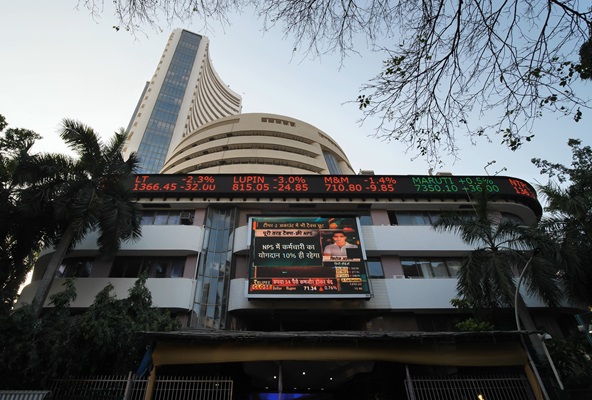.png)

By Krishnadevan V
Krishnadevan is Consulting Editor at BasisPoint Insight. He has worked in the equity markets, and been a journalist at ET, AFX News, Reuters TV and Cogencis.
October 6, 2025 at 8:36 AM IST
"Daag Acche Hain" was a brilliant Indian detergent campaign that reframed childhood messes from problems into adventures.
Parents should embrace messy play, the ad suggested, because Surf Excel detergent would handle cleanup effortlessly. Today's spin masters have hijacked this playbook with alarming audacity, transforming every bruise into a badge of honour.
Just as the detergent ad convinced parents that stains were signs of healthy childhood exploration, market mavens now peddle the narrative that every negative development signals positive opportunities ahead. The parallels are perfect and perilous.
Indian markets seem to have entered their detergent era. Tariffs are wrapped in patriotic packaging, soft consumption is presented as evidence of trading up, AI disruption is rebranded as productivity enhancement, and visa trouble is recast as a strategic tailwind. Even the awkward decision to play cricket with Pakistan in the Asia Cup is celebrated as a television ratings bonanza.
What can, at best, be a crisis management tool has evolved into a full-blown investment strategy. Negative developments are not just rationalised; they are re-engineered into growth narratives, monetised through marketing decks, and rewarded with re-ratings. The result is an investment landscape where a blot is no longer a warning sign but a branding opportunity. It’s not analysis anymore, it’s spin-fluencing.
The playbook is now almost ritualistic. First, a shock spills across earnings or sentiment. Then, narratives are quickly applied like soap to reframe the problem as a feature.
Companies respond with selective metrics, capital allocation tweaks or linguistic gymnastics that transform uncomfortable questions into fashionable talking points. Finally, the sell side, fund managers and corporate communications teams run the spin cycle, ensuring that by the time investors notice, the stain has already been priced in.
Tariffs offer the clearest example. Trade protection has been draped in the language of self-reliance and import substitution, with little discussion of input inflation, consumer welfare or retaliation risk. Listed manufacturers are recast as national champions with superior pricing power, while households quietly foot the bill. It is a neat trick, turning a tax on trade into a moat for margins.
The consumption slowdown has received a similarly generous wash. Weak rural demand and stagnating volumes would normally ring alarm bells, yet they are now explained away through the language of premiumisation.
Technology has produced its own frothy narratives. The arrival of generative AI threatens traditional IT services models built on billing hours and human capital, but this uncomfortable shift has been reframed as a productivity revolution. Firms speak of platformisation, higher realisation per employee and smarter delivery models. What is less discussed is rising capital intensity, wage stickiness and delivery risk.
Investors would do well to remember that not every transformation story ends with fatter margins.
Visa uncertainty has followed a similar arc. Restrictions on US H-1B visas ought to be a headwind for Indian IT companies, yet they have been spun as a tailwind for offshore delivery and global capability centres. The operational challenges that come with stretched delivery chains and lower onsite intimacy are rarely front and centre in this new story. As with tariffs and AI, the narrative is doing the heavy lifting.
Even cricket has not escaped the detergent treatment. India’s decision to face Pakistan in the Asia Cup is diplomatically awkward, but broadcasters, advertisers and betting markets were ecstatic. Television Rating Points surged, ad inventory got cleared, and the game was sold as a celebration of shared passion and compliance with regulatory requirement. Questions of doublespeak by politicians and geopolitics were conveniently parked outside the stadium.
These are not isolated events. Mutual funds need investors to stay the course, so they turn every setback into a signal of resilience. The asset management industry operates this reframing machinery with masterful precision. And talking heads on business television reel out the systematic investment plan playbook when markets crater. They transform portfolio damage into “averaging opportunity” while bear markets morph into “wealth-building” opportunities. Brokers require a bullish hook, so they back-test optimism until a buying opportunity emerges. Companies tweak their language faster than their business models, while PR firms alchemise earnings misses into stories of reinvention.
For investors, the challenge is to look past the foam and inspect the fabric. Volume trends reveal whether premiumisation is genuine or merely compensating for weakness. Real pricing power must be measured against inflation and taxes, not against talking points. Cash conversion, capex discipline and export dependencies are more reliable guides than repeated invocations of resilience, moat or platform.
Many stocks now trade with a stain premium that relies more on storytelling than on fundamentals. When the soap runs out, valuations often revert faster than earnings recover. Markets reward resilience, but they are ruthless with rationalisation.
The rinse cycle doesn’t care about your narrative.




